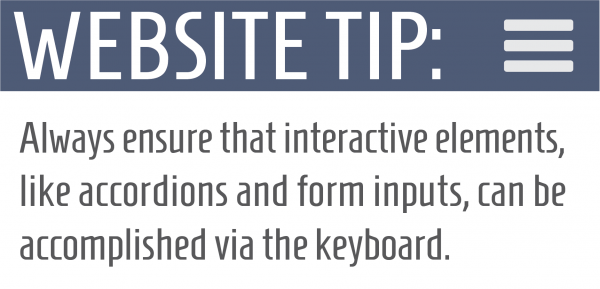With upcoming legislation around website accessibility, it’s time to take a serious look at how your website stands up to accessibility requirements.

The WAI (Web Accessibility Initiative) categorizes web accessibility into three levels: A, AA, and AAA – from basic to most advanced. Proposed upcoming legislation is aimed at requiring mainstream institutions like financial, education and healthcare to meet a minimum standard of AA.
4 Areas of Importance for Web Accessibility
So how do you stack up? When it comes to accessibility, it’s important for your website to be:
- Perceivable: That means using contrast, image text alternatives and information that’s legible.
- Operable: Support mouse alternatives, such as keyboard navigation.
- Understandable: Include clear instructions, purpose and action items.
- Robust: In other words, your site must work reliably with assistive technologies.
(Further details are outlined on the w3C website.)
Of course, websites should already be applying many of these techniques, at least on a surface level. Not only are these best practices beneficial for all users, but there are many side benefits, too, such as improved SEO (particularly in the case of alt text). Everyone can benefit from good contrast, clear action items and straight-forward error messages. Even tab navigation can come in handy.

More About the AA Standard
While many of the surface accessibility features benefit all users, the AA standard goes much, much deeper. It calls for not just contrast, but high contrast, and specific criteria for ensuring that interactive elements like accordions and form inputs can be accomplished via the keyboard.
In addition to more rigorous interface requirements for the AA standard, the code itself plays a key role for the screen reader by notating each section of the website, so the audio outputs a sensible hierarchy and flow. The code also helps the screen reader distinguish between content elements, actionable items and media.
Is your website accessible? It might be time to give it another look. And if you want to learn more about the latest standards, let us know. We’ll be happy to help.

